The Narrative Unit was a great way for seniors to express themselves freely through the use of media and or writing. Narrative all began in English with the start of the Lyrical Essay which copulates the writer’s emotion and opinion through poetic writing and stylistic writing choices. During the lyrical essay unit, I was able to express my opinion on social media and how it affects our demographic through unique storytelling and stylistic choices that has to do with the formatting of the essay. During the writing process of the essay, I really wanted to show how the essay was broken up and jumbled in order to represent my thoughts
A Social Doubt
I never knew what my mother meant when she told me that I was on the phone too much. To my mother’s eyes, every problem I seemed to have had to do with my phone.
Tired? Oh, it must be the phone.
Sick? You’re using your phone too much.
Broken leg? It’s always the damn phone.
In her eyes, I was obsessed with my phone. I never realized that being on my phone 24/7 became normal to me when it was not expected. To this day, I think my phone, social media in particular, has taken over a significant part of my life.
The development of the internet was revolutionary to society, as it enabled billions of people in the world to find what they needed with just one click. The nearest coffee shop is now a single click away, along with our math homework, our friends, and even our family trees. Every day, we scroll through Instagram, Snapchat, and Facebook to text our friends and share our thoughts with the world around us. We feel as connected as ever. The internet brings us all together, but in a way, it also tears us apart, especially with its ability to make social media more accessible.
I remember getting my first cell phone back in elementary school. It was an old Samsung Galaxy 2, but I got excited that I was able to call my friends and family anywhere and anytime. Then, I discovered social media platforms like Facebook and Instagram. Because all of my friends had it, the peer pressure caused me to compulsively download the apps and post photos. My first post was, how do you say, semi-successful. The more likes and comments I received, the more I felt good about myself. This love for attention made me become a completely different person online, causing me to feel like I needed to keep up this persona in order for people to like me.
My experience with the internet and social media is more common than many may think. In particular, it is very common with social media celebrities in the fitness industry. As we scroll through social media, we often see men posing with perfectly symmetrical features, washboard abs, and twenty-two-inch biceps with a shoulder to waist ratio of an upside-down Dorito. Or sometimes we see women with tiny waists and big hips to be shaped like an “hourglass”. We then find ourselves pondering how anyone could look so perfect and forming new insecurities based on our inabilities to achieve unachievable perfection. In reality, these “perfect” beings only look like this for a small fraction of their life. However, the impact that these superficial images have on society is tremendous, as it causes us to thrive on approval from social media, which prevents people from genuinely living their lives.
So how do we combat this? Comparing ourselves to others and worrying about what others think is simply human nature and not under our control, but we can control the way we think about ourselves. The reason we care so much about our appearances online is that we are scared about what other people think about us.
Does she like me?
Does he like me?
Do they think I’m showing off?
Am I bragging? We think these thoughts every time we post online, but we genuinely do not know how other people think about us. That is why I believe the phrase, “don’t let other people’s thoughts affect you” is greatly misunderstood. Personally, I have come to realize that other people’s thoughts are simply a reflection of our own thoughts. These thoughts, which stem from the negative emotions we feel about ourselves, give us self-doubt and can prevent us from doing the things we want. In order to eliminate this self-doubt, we can start thinking positive thoughts about ourselves. As I had fun scrolling through social media, I came to understand that social media has become a platform that will forever be responsible for my self-doubt.
Intention
Through this essay, I wanted to convey my personal experience with Self-image problems through the use of social media platforms. I knew that this was a subject that I wanted to write about when I found myself in the past obsessing with the thought of the likes and comments I get on each Instagram post. I was someone who craved attention, and in response that changed the type of person, I was in real life. Through the structure of this essay I wanted it to represent my “ thoughts “ in a way. I wanted to show how my thought process through looking at likes and comments and how it changes me throughout my life. I wanted it to progress in a way of self-realization, by having the last paragraph end with realizing that caring about what other people think is the manifestation of your own negative thoughts. I also wanted the essay to sound like it is being read by the voice in my head, and in order to interpret that, some parts of the essay seem to be more of a conversation form rather than an essay. A literal influence I wanted to emulate through this essay was ross gay’s poetic writing style. I enjoyed how he used metaphors in his work, and the way he was able to talk about the subject of racism through personal experiences. I was trying to do that with my essay by showing my personal experiences and using examples of social media posts to further add to my point. Some feedback I used was that I needed to make this essay more personal and less research-based in order to make it creative. I did this by removing a few quotes and implementing more of my own experiences. A suggestion that was made to me was that I needed to use the word “ I “ more instead of constantly summarizing the sources I found online. This in my opinion really made my essay stronger because I was able to touch on more personal subjects instead of just restating what is already stated in the quote.
Digital Media
Next, we moved on to digital media, where we were asked to create multi-layer art using different mediums with Adobe Illustrator. The two choices that were given were either a wood carving or a lightbox. For Matthew and I, we decided to do a lightbox in order to capture the scene. For our idea, we decided to make a lightbox on a character that was a childhood favorite of Matthew and me and that was, Itachi. We put Itachi on a rock pedestal surrounded by a tree and mountains. In the distance, you’ll spot some birds as the sun shined upon all of them.
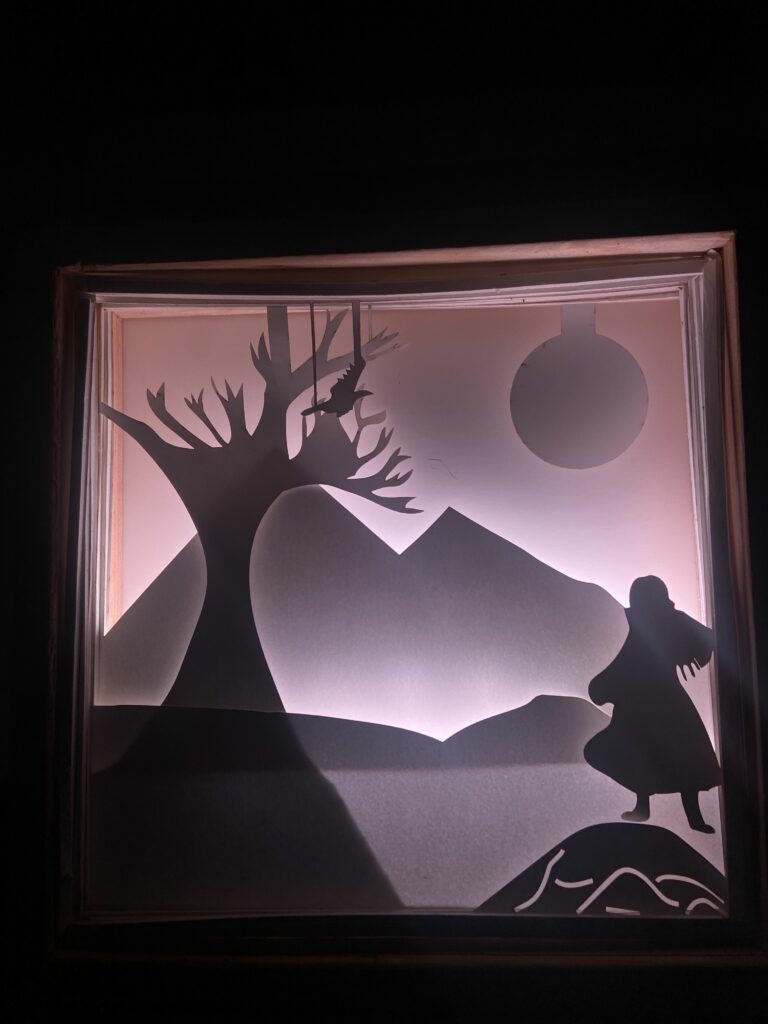
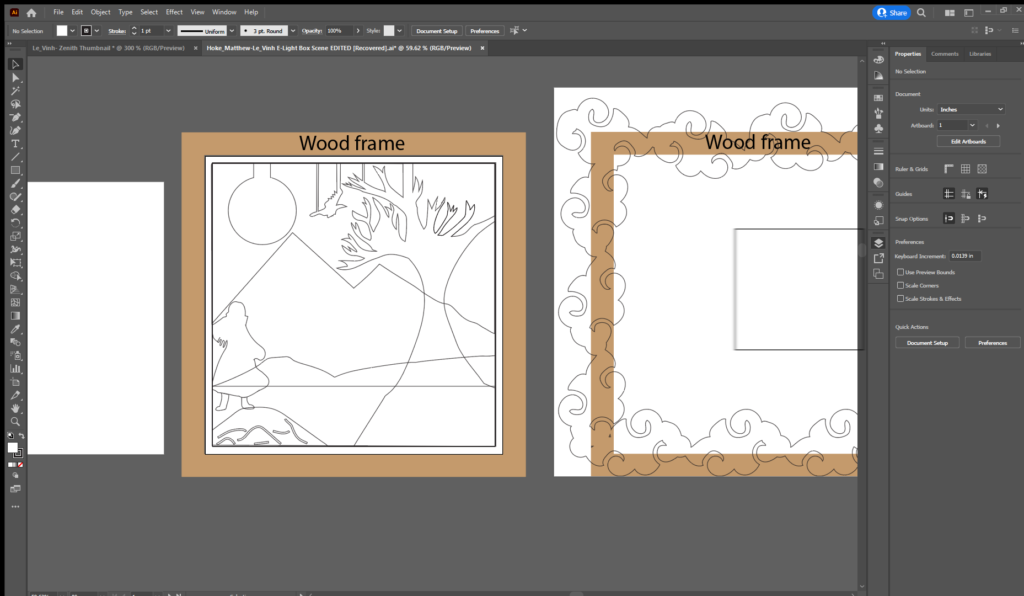
my inspiration for this project was based on my favorite show which is Naruto. one of the characters that I enjoyed watching as a kid was itchy. Although he got very little screen time, it was very cool seeing him pop in once in a while. For the background of the image, I decided to use Palo Alto badlands as a reference since I was always there as a kid some of the struggles that this project created for me would be getting the Illustrator file to work properly in order for the art to print out. I ran into a few problems that involved connecting the pieces together. For example, there were some pieces that wouldn’t connect to the border of the artwork, which in return made it so we had to change our artwork. Overall, doing this project was definitely a learning experience in both adobe after effects and illustrator. I was able to learn how to create a multi-layer, multi-media piece of artwork that many other people can enjoy in the future. Overall the experience was great and I enjoyed working on myself. I can use some of these skills in the future to create a better piece of artwork
Film
Finally, we moved on to film, where we were introduced to the biggest freestyle project of all time, our senior narrative. In the Senior Narrative Unit, we were asked to create a full narrative short film complete with a complete plot, characters, and of course dialog. Unlike our narrative unit from last year, this narrative unit is the amalgamation of all our narrative skills, and refining them into a Senior Film. From story development to characters, shots, lighting and etc, Everything that we learned last year and this year, goes into this Film. In order to do this project effectively, the process was broken down into three different parts: Pre-production, production, and Post Production
Pre Production
Our pre-production process is the biggest process out of the three, but it gave students a big jumpstart in the planning phase of the project in order to make the production phase a lot simpler. During this stage first came up with a log line of our story. A logline is a sentence that basically captures the main idea of the story. For example, mine was ” the man who stole the car realizes he is not alone. From there we then create a synopsis of our story After the synopsis, we were asked to share our synopsis in order to give feedback to each other.
Synopsis
The story starts off with a man who planned to rob a car. He spots a car in the distance with the window slightly open and decides to steal it. After hustling the door to unlock it, he realizes that the car was already unlocked and that the key was left in the ignition. To his surprise, as he was driving he spotted a hand in the rearview mirror and noticed a kid. He is baffled and bewildered. There is a kid in the car. The man tries to get the kid to leave but the kid states that it is his car and that he has nowhere to go. The man decides it’s best to give the car back to the kid once he reaches his destination, and they both agree to do so. Both the kid and the man are visually and emotionally separated as they go on for the rest of the drive. The man and kid decide to get food. Here they tell more about themselves to each other and list out the kid’s backstory and why he’s alone in the car. The man and the kid head out but the man feels bad for the kid due to his lack of clothes. They make a pit stop at a retail store. Both the man and the kid walk in and the man decides to get new clothes for the kid. They both don’t have money so the man tries to have the kid steal the clothes while the man distracts the store clerk. The man has the store clerk walk around the other side of the store with him as the kid is taking as many clothes as possible. When the kid is done he decides to leave and gets close to the door but then trips and spills all the clothes. A loud thud can be heard, and both the man and store clerk turn around. The store clerk screams at the kid telling him to put back all the clothes and call 911. The man tries his best to stop the store clerk from dialing 911 but it’s too late. The cops are on their way. The man decides it’s best to tie up the store clerk and tape his mouth shut so he doesn’t speak. The man doesn’t want to but he left him no choice. When the cops come the man locks the front door. The cops can be heard outside asking for them to come out. The man refuses, saying he has a gun and a hostage hesitantly because in reality, he doesn’t actually have a gun. The cops say that it’s best for them to come out or they will have to come in. The man decides it’s best for the kid to grab the clothes and then the car and make a run for it. The man doesn’t want the kid to become a criminal like him. The story ends with the man on the ground, arrested, and the kid escaping the store without notifying the police.
From the synopsis, we moved on to actually writing the story out with plot development and dialog. This is what’s known as a written screenplay. This part of preproduction was the most important as it is the root and stem of the project. A film is not good without a good story, so Reed and I had to make changes here and there to make the story better. We then shared out our screenplay with our peers, got feedback, and revised it. Multiple, multiple times. After we were 90 percent confident with our story. We highlighted the screenplay in order to section it off into categories. For example, dialog, props, location, and etr. This kept everything 100 times more organized.
After the Screenplay, we were then asked to create a shot list, find actors and locations, and create a shooting schedule based on the assigned days. You see, a lot of planning goes into this project, but this ensures that students has a smooth transition into the production phase.
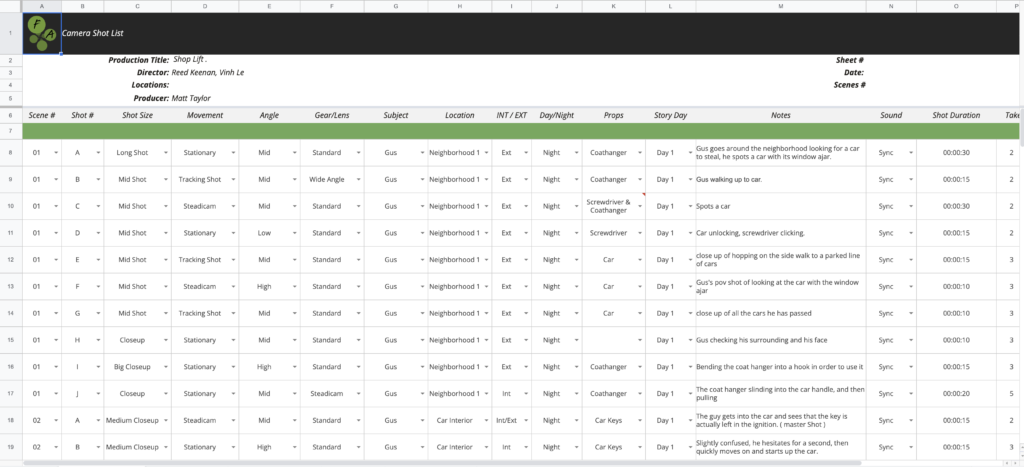
For the shortlist, we were asked to create a google spreadsheet, complete with all the different shots and angles that we wanted to include in our film, as well as the duration of each shot, the characters that were in each shot, the location of each shot, and the props that we needed for the shot.
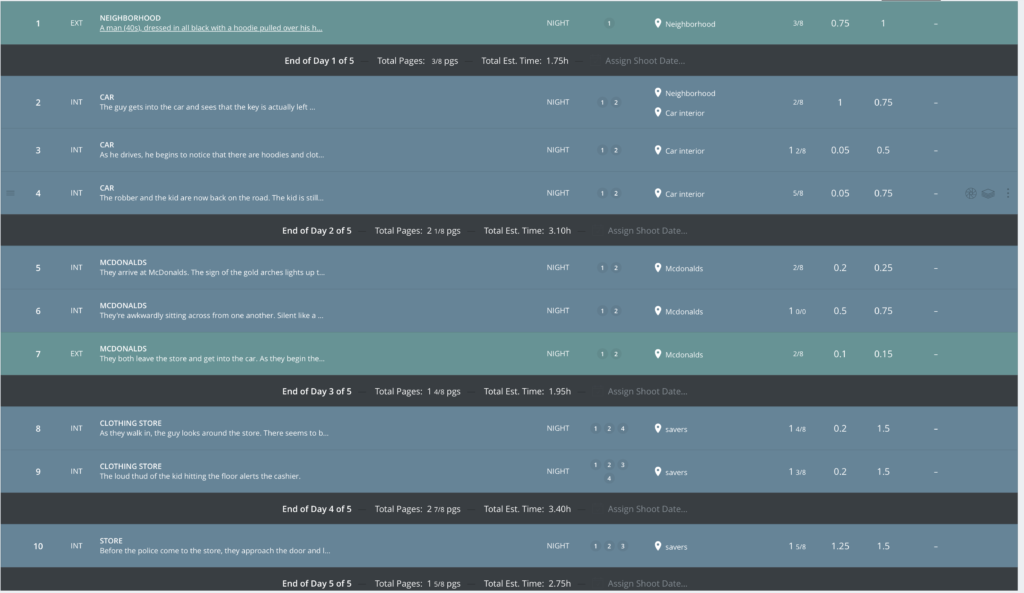
From here, we found our actors and shooting locations. After we got everybody up to date with what’s going on, we created a strip-board that showed us which shot we needed on a specific day.
George Ison – The Robber
Elias V – The Kid
Mike M- The Police
Arya H- Mike
In order to learn how to direct and get a sense of acting, students were also given the opportunity to act out famous scenes from their favorite movie. For Jonah and I, we decided to do a iconic twilight scene where Edward leaves Bella. This was definitely a learning experience as it taught most film students the ways to effectively direct actors and get the most out of a actor in a scene. From acting, we move to editing, as we learned how to create a effective dialog scene with Multicam editing

PRODUCTION AND POST PRODUCTION
After the heavy Preproduction, we actually move on to begin filming our narrative. This process took many weeks and many hours, as we had to do our production based on the Shot list and strip-board. The shooting process had the funnest nights I’ve ever had shooting a fitm. We were able to work with new actors and fuse techniques that we were never able to use before. One technique specifically that we used was Projection Screening. This involved the use of a projector and lights in order to make it look like George was actually driving the car.

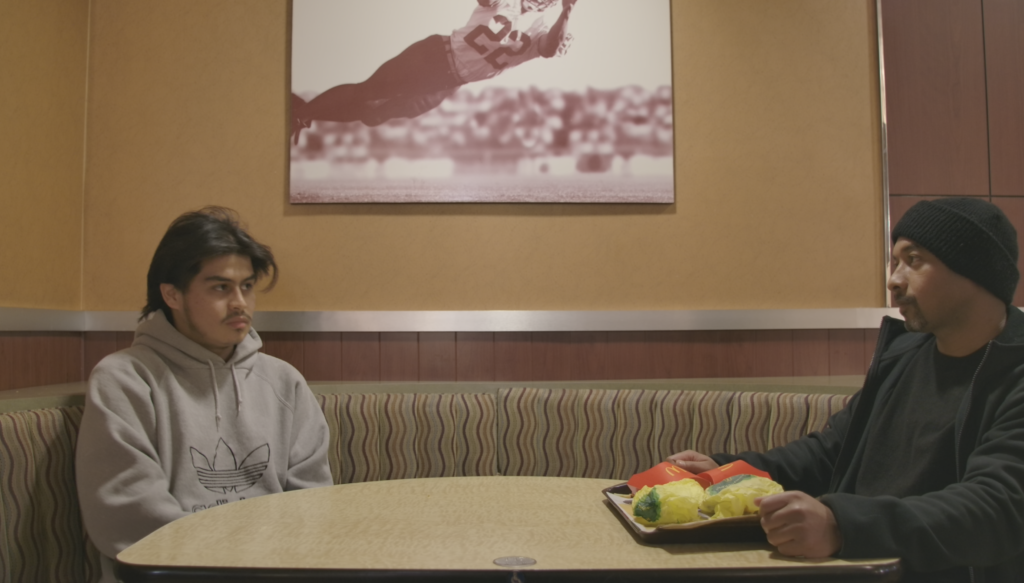
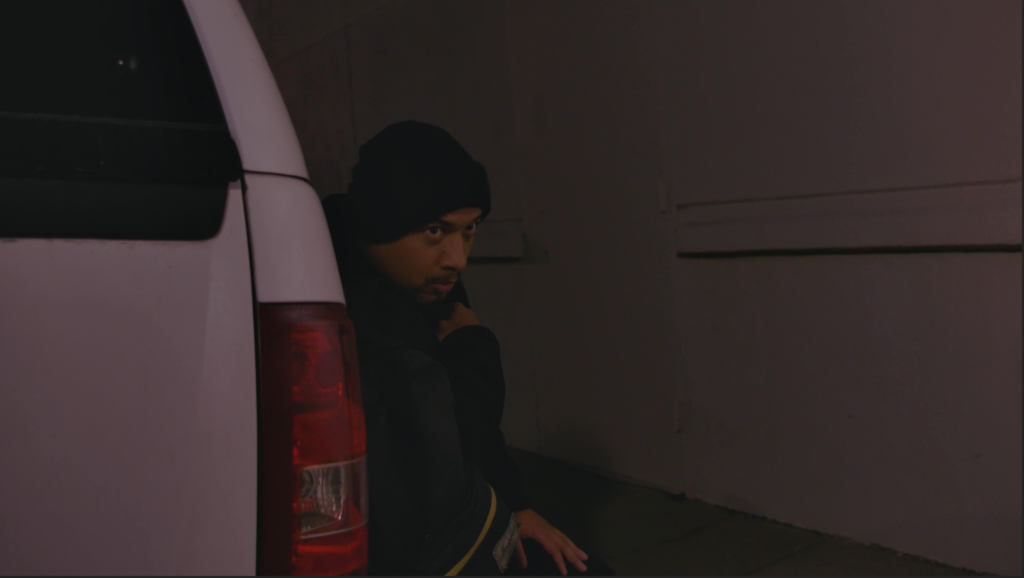
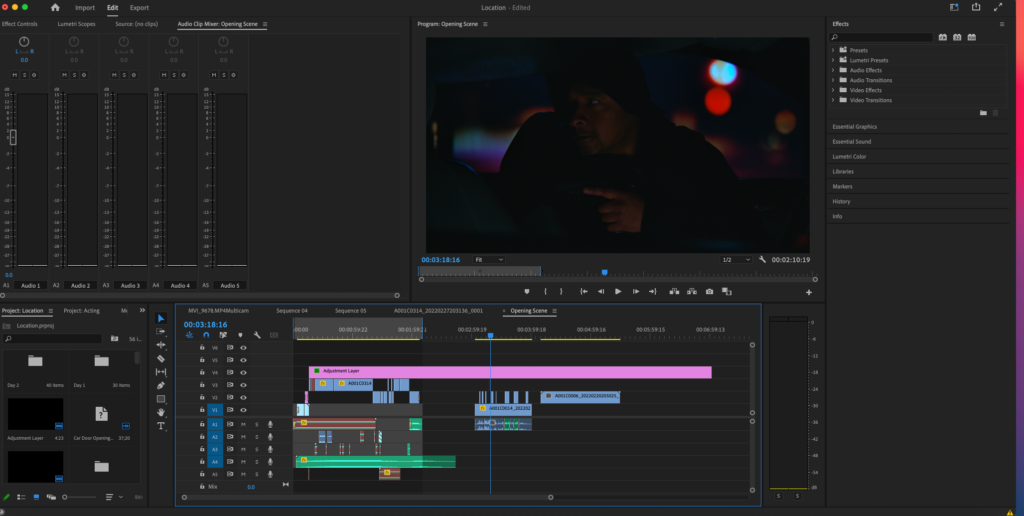
overall the narrative was definitely one of the most tedious but fun experiences that I had at freestyle so far. it was great learning real world film techniques and I was actually able to get experience on what its like to work in the film industry. This project showed me how much real work goes into a film, and how planning is required to actually make the Post and Production phase easier. Overall, I am thankful to be given this opportunity at freestyle to create my own feature length film.
